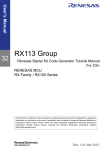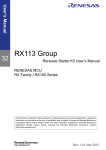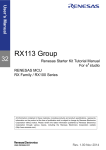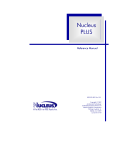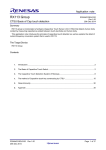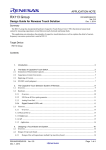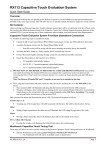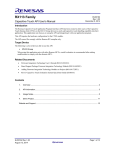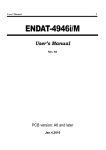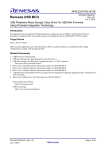Download Renesas Starter Kit for RX113 Boot Loader Application Note
Transcript
User’s Manual 32 RX113 Group Renesas Starter Kit for RX113 Boot Loader Application Note RENESAS MCU RX Family / RX100 Series All information contained in these materials, including products and product specifications, represents information on the product at the time of publication and is subject to change by Renesas Electronics Corporation without notice. Please review the latest information published by Renesas Electronics Corporation through various means, including the Renesas Electronics Corporation website (http://www.renesas.com). Rev. 1.00 Nov 2014 Notice 1. Descriptions of circuits, software and other related information in this document are provided only to illustrate the operation of semiconductor products and application examples. You are fully responsible for the incorporation of these circuits, software, and information in the design of your equipment. Renesas Electronics assumes no responsibility for any losses incurred by you or third parties arising from the use of these circuits, software, or information. 2. Renesas Electronics has used reasonable care in preparing the information included in this document, but Renesas Electronics does not warrant that such information is error free. Renesas Electronics assumes no liability whatsoever for any damages incurred by you resulting from errors in or omissions from the information included herein. 3. Renesas Electronics does not assume any liability for infringement of patents, copyrights, or other intellectual property rights of third parties by or arising from the use of Renesas Electronics products or technical information described in this document. No license, express, implied or otherwise, is granted hereby under any patents, copyrights or other intellectual property rights of Renesas Electronics or others. 4. You should not alter, modify, copy, or otherwise misappropriate any Renesas Electronics product, whether in whole or in part. Renesas Electronics assumes no responsibility for any losses incurred by you or third parties arising from such alteration, modification, copy or otherwise misappropriation of Renesas Electronics product. 5. Renesas Electronics products are classified according to the following two quality grades: “Standard” and “High Quality”. The recommended applications for each Renesas Electronics product depends on the product’s quality grade, as indicated below. “Standard”: Computers; office equipment; communications equipment; test and measurement equipment; audio and visual equipment; home electronic appliances; machine tools; personal electronic equipment; and industrial robots etc. “High Quality”: Transportation equipment (automobiles, trains, ships, etc.); traffic control systems; anti-disaster systems; anticrime systems; and safety equipment etc. Renesas Electronics products are neither intended nor authorized for use in products or systems that may pose a direct threat to human life or bodily injury (artificial life support devices or systems, surgical implantations etc.), or may cause serious property damages (nuclear reactor control systems, military equipment etc.). You must check the quality grade of each Renesas Electronics product before using it in a particular application. You may not use any Renesas Electronics product for any application for which it is not intended. Renesas Electronics shall not be in any way liable for any damages or losses incurred by you or third parties arising from the use of any Renesas Electronics product for which the product is not intended by Renesas Electronics. 6. You should use the Renesas Electronics products described in this document within the range specified by Renesas Electronics, especially with respect to the maximum rating, operating supply voltage range, movement power voltage range, heat radiation characteristics, installation and other product characteristics. Renesas Electronics shall have no liability for malfunctions or damages arising out of the use of Renesas Electronics products beyond such specified ranges. 7. Although Renesas Electronics endeavors to improve the quality and reliability of its products, semiconductor products have specific characteristics such as the occurrence of failure at a certain rate and malfunctions under certain use conditions. Further, Renesas Electronics products are not subject to radiation resistance design. Please be sure to implement safety measures to guard them against the possibility of physical injury, and injury or damage caused by fire in the event of the failure of a Renesas Electronics product, such as safety design for hardware and software including but not limited to redundancy, fire control and malfunction prevention, appropriate treatment for aging degradation or any other appropriate measures. Because the evaluation of microcomputer software alone is very difficult, please evaluate the safety of the final products or systems manufactured by you. 8. Please contact a Renesas Electronics sales office for details as to environmental matters such as the environmental compatibility of each Renesas Electronics product. Please use Renesas Electronics products in compliance with all applicable laws and regulations that regulate the inclusion or use of controlled substances, including without limitation, the EU RoHS Directive. Renesas Electronics assumes no liability for damages or losses occurring as a result of your noncompliance with applicable laws and regulations. 9. Renesas Electronics products and technology may not be used for or incorporated into any products or systems whose manufacture, use, or sale is prohibited under any applicable domestic or foreign laws or regulations. You should not use Renesas Electronics products or technology described in this document for any purpose relating to military applications or use by the military, including but not limited to the development of weapons of mass destruction. When exporting the Renesas Electronics products or technology described in this document, you should comply with the applicable export control laws and regulations and follow the procedures required by such laws and regulations. 10. It is the responsibility of the buyer or distributor of Renesas Electronics products, who distributes, disposes of, or otherwise places the product with a third party, to notify such third party in advance of the contents and conditions set forth in this document, Renesas Electronics assumes no responsibility for any losses incurred by you or third parties as a result of unauthorized use of Renesas Electronics products. 11. This document may not be reproduced or duplicated in any form, in whole or in part, without prior written consent of Renesas Electronics. 12. Please contact a Renesas Electronics sales office if you have any questions regarding the information contained in this document or Renesas Electronics products, or if you have any other inquiries. (Note 1) “Renesas Electronics” as used in this document means Renesas Electronics Corporation and also includes its majority owned subsidiaries. (Note 2) “Renesas Electronics product(s)” means any product developed or manufactured by or for Renesas Electronics. (2012.4) Disclaimer By using this Renesas Starter Kit (RSK), the user accepts the following terms: The RSK is not guaranteed to be error free, and the entire risk as to the results and performance of the RSK is assumed by the User. The RSK is provided by Renesas on an “as is” basis without warranty of any kind whether express or implied, including but not limited to the implied warranties of satisfactory quality, fitness for a particular purpose, title and non-infringement of intellectual property rights with regard to the RSK. Renesas expressly disclaims all such warranties. Renesas or its affiliates shall in no event be liable for any loss of profit, loss of data, loss of contract, loss of business, damage to reputation or goodwill, any economic loss, any reprogramming or recall costs (whether the foregoing losses are direct or indirect) nor shall Renesas or its affiliates be liable for any other direct or indirect special, incidental or consequential damages arising out of or in relation to the use of this RSK, even if Renesas or its affiliates have been advised of the possibility of such damages. Precautions The following precautions should be observed when operating any RSK product: This Renesas Starter Kit is only intended for use in a laboratory environment under ambient temperature and humidity conditions. A safe separation distance should be used between this and any sensitive equipment. Its use outside the laboratory, classroom, study area or similar such area invalidates conformity with the protection requirements of the Electromagnetic Compatibility Directive and could lead to prosecution. The product generates, uses, and can radiate radio frequency energy and may cause harmful interference to radio communications. However, there is no guarantee that interference will not occur in a particular installation. If this equipment causes harmful interference to radio or television reception, which can be determined by turning the equipment off or on, you are encouraged to try to correct the interference by one or more of the following measures; • ensure attached cables do not lie across the equipment • reorient the receiving antenna • increase the distance between the equipment and the receiver • connect the equipment into an outlet on a circuit different from that which the receiver is connected • power down the equipment when not in use • consult the dealer or an experienced radio/TV technician for help NOTE: It is recommended that wherever possible shielded interface cables are used. The product is potentially susceptible to certain EMC phenomena. To mitigate against them it is recommended that the following measures be undertaken; • The user is advised that mobile phones should not be used within 10m of the product when in use. • The user is advised to take ESD precautions when handling the equipment. The Renesas Starter Kit does not represent an ideal reference design for an end product and does not fulfil the regulatory standards for an end product. How to Use This Manual 1. Purpose and Target Readers This application note is designed to provide the user with an understanding of how the System_Bootloader sample works, in order to provide a guide on how such systems may be developed on a RX113 based system. It is intended for users working with a RSKRX113 platform. Further details regarding operating the RX113 microcontroller may be found in the Hardware Manual and within the sample code. The following documents applying to the RSK RX113 may provide assistance. Refer to the device specific versions located on the installation of the RSK software or check the Renesas Electronics Web site for the latest versions. Document Type Description Document Title Document No. User’s Manual Describes the technical details of the RSK hardware. RSKRX113 Manual User’s R20UT2756EG Tutorial Provides a guide to setting up RSK environment, running sample code and debugging programs. RSKRX113 Tutorial Manual CS+: R20UT2757EG e2 studio: R20UT2760EG Quick Start Guide Provides simple instructions to setup the RSK and run the first sample. RSKRX113 Start Guide Quick CS+: R20UT2758EG e2 studio: R20UT2761EG Code Generator Tutorial Manual Provides a guide to code generation IDE. Schematics Full detail circuit schematics of the RSK. Hardware Manual Provides technical microcontroller. Application Note details of the RSKRX113 Code Generator Tutorial Manual RSKRX113 Schematics RX113 RX113 User’s Hardware CS+: R20UT3254EG e2 studio: R20UT3255EG R20UT2755EG Group, Manual: R01UH0448EJ Application note for the Renesas Flash Module Using Firmware Integration Technology. RX Family Flash Module Using Firmware Integration Technology R01AN2184EU Application Note Application note detailing the use of Flash API without the Renesas Board Support Package. RX Family Using the Simple Flash API for RX without the r_bsp Module R01AN1890EU Application Note Application note detailing the operation of the RSK RX113 Bootloader Sample Program. RSKRX113 Bootloader Application note R20AN0339EG 2. List of Abbreviations and Acronyms Abbreviation Full Form API Application Program Interface bps Bootloader Bits Per Second Program designed to update firmware on a device while it is running in application CGC CPU Clock Generation Circuit Central Processing Unit CRC E1 Cyclic Redundancy Check Renesas On-chip Debugging Emulator FSL GUI Flash Self-programming Library Graphical User Interface 2 I C (IIC) IRQ Philips™ Inter-Integrated Circuit Connection Bus Interrupt Request ISR LCD Interrupt Service Routine Liquid Crystal Display LED LSB Light Emitting Diode Least Significant Bit MCU NAK (NACK) Micro-controller Unit Negative Acknowledgement RSK Renesas Starter Kit All trademarks and registered trademarks are the property of their respective owners. Table of Contents 1. Overview............................................................................................................................ 7 1.1 1.2 Purpose ...................................................................................................................................................... 7 Features ..................................................................................................................................................... 7 2. Introduction ........................................................................................................................ 8 3. System Bootloader ............................................................................................................ 9 3.1 3.2 3.3 Memory Map - Flash .................................................................................................................................. 9 Memory Map - RAM ................................................................................................................................... 9 Operation ................................................................................................................................................. 11 4. Vector Handling ............................................................................................................... 12 4.1 4.2 4.3 Re-locatable Vector table ......................................................................................................................... 12 Fixed Vector table .................................................................................................................................... 12 Code Description ..................................................................................................................................... 14 4.3.1 XModem transfer implementation .................................................................................................. 15 4.3.2 Flash API and FIT .......................................................................................................................... 15 4.4 Bootloader Section Link Addresses ......................................................................................................... 15 4.5 Considerations for Bootloader Application Code ..................................................................................... 15 4.5.1 Section Link Addresses .................................................................................................................. 15 4.5.2 Fixed Register Configuration.......................................................................................................... 16 4.5.3 Microcontroller Defaults ................................................................................................................. 16 5. Additional Information ...................................................................................................... 17 RSKRX113 RENESAS STARTER KIT R20AN0339EG0100 Rev. 1.00 Nov 30, 2014 1. Overview 1.1 Purpose The RSK is an evaluation tool for Renesas microcontrollers. This application note describes the operation of the System Bootloader sample code on the RSK platform with a view to aiding development of similar applications. 1.2 Features The System Bootloader sample code demonstrates the ability to update application code via SCI while the system is running, using a standard S-Record or hex programmer file format. It incorporates system integrity checking facilities such as CRC Flash memory verification and a watchdog. The RSK board contains all the circuitry required for microcontroller operation. R20AN0339EG0100 Rev. 1.00 Nov 30, 2014 Page 7 of 21 RSKRX113 2. Introduction 2. Introduction This application note is designed to illustrate how the System Sample: System_Bootloader provides the ability to update application code located in on-board Flash memory on the MCU whilst running, via a serial connection from a PC or equivalent device. R20AN0339EG0100 Rev. 1.00 Nov 30, 2014 Page 8 of 21 RSKRX113 3. System Bootloader 3. System Bootloader 3.1 Memory Map - Flash In order to understand the operation of the Bootloader and Application system it is important to have an appreciation of the memory space in which they are operating. This is shown in Figure 3.1 Flash Memory Map. At the top of the flash memory is the Bootloader code, including the Flash Self-Programming Library. Following this is the space for the Application Code, this area will hold the code for the application programmed using the Bootloader. This includes a pseudo-fixed vector table for the Application. The RX113 fixed reset and exception vectors are located between addresses 0xFFFFFFD0 & 0xFFFFFFFF. The fixed reset vector always points to the Bootloader code to ensure that the system can verify the Application code space in the event of a reset. Above this lies an area containing option bytes, endian select registers and security ids. In the addresses immediately above is the user application area checksum bytes. This checksum is calculated and verified by the Bootloader to determine if the application area contains a valid application. 3.2 Memory Map - RAM The RX113 fitted to the RSK has 64k bytes of RAM. Because Application code and Bootloader code run entirely separately, there is no shared RAM between them and no restrictions placed on application RAM use. R20AN0339EG0100 Rev. 1.00 Nov 30, 2014 Page 9 of 21 RSKRX113 3. System Bootloader FFF80000h Boot Loader Program and Flash Library - FFF85000h KEY Bootloader Flash Memory Area Application Flash Memory Area Application Fixed Vector Table Application Code Space FFFFFF40h FFFFFF44h Application Pseudo-Fixed Vectors FFFFFF44h Privileged instruction exception FFFFFF48h (Reserved) FFFFFF4Ch (Reserved) FFFFFF50h Undefined instruction exception FFFFFF54h (Reserved) FFFFFF58h (Reserved) FFFFFF5Ch (Reserved) FFFFFF60h (Reserved) FFFFFF64h (Reserved) FFFFFF68h (Reserved) FFFFFF6Ch Non-maskable interrupt FFFFFF70h Application Reset FFFFFF70h Application Checksum Endian Select & Options FFFFFFD0h Boot Loader Fixed Vectors FFFFFFFFh FFFFFFD0 FFFFFFD4 FFFFFFD8 FFFFFFDC FFFFFFE0 FFFFFFE4 FFFFFFE8 FFFFFFEC FFFFFFF0 FFFFFFF4 FFFFFFF8 FFFFFFFC Bootloader Fixed Vector Table Privileged instruction exception (Reserved) (Reserved) Undefined instruction exception (Reserved) (Reserved) (Reserved) (Reserved) (Reserved) (Reserved) Non-maskable interrupt Reset (initial entry) Figure 3.1 Flash Memory Map R20AN0339EG0100 Rev. 1.00 Nov 30, 2014 Page 10 of 21 RSKRX113 3.3 3. System Bootloader Operation Figure 3.2 Bootloader Flow Chart shows the workflow for the Bootloader Start – Power up RSK Reset Yes Is SW1 Pressed? Yes No Calculate CRC for Application Code Space CRC matches Stored Value? Erase Application Code Area No Download and program code to Flash via UART Yes Read Application start address and Jump to Application Yes Is SW2 Pressed? No Error? No Running Application Code Figure 3.2 Bootloader Flow Chart The MCU starts operation always by jumping to the location pointed to by the Bootloader fixed reset vector. This reset vector starts operation of the Bootloader (Not the Application). The Bootloader is responsible for deciding whether to run code located within the Application area, or to download new code via SCI and reprogram the flash area with this code. The Bootloader decides to update the Application if SW1 is pressed when the RSK starts or if a CRC check of the Application code space determines that the code is invalid. The firmware update procedure consists of first erasing the Application code space, followed by reading in new code from a programmer file in S-Record or Intel Hex format received via a SCI connection from the RL78G1C USB to Serial converter, and programming the Application Flash block by block. Once Application flash programming is complete, the Bootloader then calculates a CRC value for the Application space and programs it to a fixed location in Flash. Once the Application update process is complete and SW2 pressed, or if the application checksum is validated at start-up, the Bootloader will jump to the start address of the Application by reading the Reset vector entry in the Application’s pseudo-fixed vector table. R20AN0339EG0100 Rev. 1.00 Nov 30, 2014 Page 11 of 21 RSKRX113 4. Vector Handling 4. Vector Handling The RX113 processor has two vector tables: Re-locatable Vector table & Fixed Vector table. 4.1 Re-locatable Vector table As the name suggests this vector table can be located anywhere in the RX113 flash area and stores addresses for the majority of standard interrupt vectors. The user application is responsible for setting the INTB register to the location of the application’s re-locatable table. 4.2 Fixed Vector table This table contains a number of reserved vectors and vectors for: Reset, Non-maskable interrupt, Undefined instruction exception & Privileged instruction exception. The RX113 uses the fixed locations of 0xFFFFFFD0 thru 0xFFFFFFFF for this vector table. This is within the bootloader address space and is not modifiable by the user’s application. The bootloader incudes a feature that forwards the vectors listed above to be services by application code. This is illustrated in Figure 4.1 Application Interrupt Forwarding Process. The user application must have a pseudo-fixed vector table located at addresses 0xFFFFFF44 thru 0xFFFFFF73. This table is in the same format as a standard fixed vector table. If an exception is generated during user application execution, the bootloader vector is invoked by the RX113. The bootloader code will read the relevant entry in the user’s pseudo-fixed vector table and perform a jump to that address. This allows the user application to service the exception/interrupt as it would if running without the bootloader. The vector forwarding requires additional processor cycles to complete, which marginally increases latency between the exception/interrupt and user’s service routine being executed. R20AN0339EG0100 Rev. 1.00 Nov 30, 2014 Page 12 of 21 RSKRX113 4. Vector Handling Boot Loader Program and Flash Library 3) Bootloader ISR Jumps to Application ISR Application Code Space 1) Exception Occurs. Jumps to ISR in Bootloader 2) Bootloader ISR reads Application ISR address from Application pseudo-fixed vector table Application Pseudo-Fixed Vectors Application Checksum Endian Select & Options Boot Loader Fixed Vectors Figure 4.1 Application Interrupt Forwarding Process R20AN0339EG0100 Rev. 1.00 Nov 30, 2014 Page 13 of 21 RSKRX113 4.3 4. Vector Handling Code Description The System_Bootloader project has been based on code generated by the Code Generator. Many configuration options can be quickly modified to suit the application using a GUI, for example, changing the baud rate of the SCI connection etc. Code Generator files prefixed by “r_cg_” are files controlled by the Code Generator and within such files it is important to make modifications only in areas between the comments such as shown. Any code additions or modifications performed outside of these comments will be overwritten if the code regenerated by Code Generator. For a more detailed guide to using Code Generator, refer to Code Generator Tutorial manual. r_cg_main.c is the file of the project containing the main function. The function main.c provides a high level guide of the process, following Figure 3.2 Bootloader Flow Chart. Function update_from_data_source guides the update procedure of reading data from the SCI and programming the Flash with this data. It handles the incoming data byte by byte, determining the format of the file being sent (Intel Hex or S-Record) automatically, and assigning function pointers to handle the data reception appropriately. When complete lines of records from the file are received, it determines what to do with the information; whether it is code and needs to be programmed to Flash or otherwise. The SCI code is in r_cg_sci.c. By default the SCI is set to use 38400 Baud, 8 Data Bits, No Parity, 1 Stop Bit. These parameters may be changed using Code Generator. To control the flow of data from the host PC, XModem transfer protocol has been employed. This is a 128-byte packet based protocol and allows the System_Bootloader to hold off further transfers from the PC while decoding and programming operations are in progress. XModem packets are fed into a buffer, which is controlled in buffer.c. The buffer is circular, i.e. when the end of the buffer is reached it loops back to the start. The buffer handling code has been deliberately constructed so as to make it easy to replace the data reception functions with those from a different communications medium. Programming or erasing Flash via the Flash Self-Programming library is achieved via the file code_flash.c. This employs functions to write to the Flash independently of block size or location, encapsulating the FSL library functions. Furthermore repetitive calls to the Flash_Write function will just append the data to a buffer held in RAM and only write the data to the Flash if new data is passed to it that lies outside of the Flash block, in order to reduce the number of Flash writes. Any remaining data held in the Flash Write buffer can be written to the Flash by calling the flash_flush_buffer function. Decoding of S-Record formatted files is handled in srec.c. Further information on the S-Record file format can be obtained at the following link: http://en.wikipedia.org/wiki/SREC_(file_format) Decoding of Intel hex formatted files is handled in hex.c. Further information on the hex file format can be obtained at the following link: http://en.wikipedia.org/wiki/Intel_HEX The Bootloader activates the watchdog timer, as a system integrity function. This is achieved in the r_cg_wdt.c file. The function R_WDT_Restart in the Bootloader code resets the watchdog to prevent timeout and reset. r_bootloader_vecttbl.c & r_bootloader_intprg.c implements the interrupt vector forwarding and replace the functionality found in the Code Generator files r_cg_vecttbl.c and r_cg_intprg.c, which are excluded from the build. R20AN0339EG0100 Rev. 1.00 Nov 30, 2014 Page 14 of 21 RSKRX113 4.3.1 4. Vector Handling XModem transfer implementation Details of the XModem protocol may be found at the following link: http://en.wikipedia.org/wiki/XMODEM. The Bootloader implements the standard XModem protocol and not any variant such as XModem-1K or XModem-CRC. In line with the standard protocol implementation, NAKs are sent by the RSK every 10 seconds before the first packet is received. As such there may be up to ten seconds delay between initialising the transfer on the terminal and the first packet being sent. A <CAN> flag is sent to the terminal if the Bootloader detects a problem during the XModem transfer. This will cancel the transfer from the PC and allow the error message to be displayed to the user. <CAN> aborts are not supported by all PC terminal programs. 4.3.2 Flash API and FIT The Renesas Flash API is used to perform the flash erase and programming. To reduce Bootloader code footprint, full Renesas Board Support Package (r_bsp) has not been used. The reduced size approach detailed in the ‘Using the Simple Flash API for RX without the r_bsp_ Module Application Note’ has been employed. 4.4 Bootloader Section Link Addresses To implement the memory map detailed in section 3.1 Memory Map, the following settings are used for the Bootloader linker sections. Address 0x00001000 0xFFF80000 0xFFFFFFD0 4.5 Section Name SU SI B_1 R_1 B_2 R_2 B R RPFRAM PResetPRG C_1 C_2 C C$* D* W* L PIntPRG P PFRAM FIXEDVECT Comment Bootloader work RAM start Start of Bootloader code Bootloader re-locatable vector table Bootloader Fixed Vector Table Considerations for Bootloader Application Code 4.5.1 Section Link Addresses The Bootloader application code and vector tables must be linked within the section shown in Figure 3.1 Flash Memory Map, summarised below. R20AN0339EG0100 Rev. 1.00 Nov 30, 2014 Page 15 of 21 RSKRX113 4. Vector Handling Address 0xFFF85000 Contents User Application Code Comment All user application code 0xFFFFFF44 to 0xFFFFFF70 Pseudo-Fixed Vector Table Pseudo-Fixed Vector Table in the standard RX113 Fixed vector table order. During download the image will be rejected if the Bootloader Application has code placed outside of the Application area shown in Figure 3.1 Flash Memory Map. If this occurs, analysis of the Bootloader Application linker map output file should indicate what has been set incorrectly. 2 Please note that Code Generator in e studio adjusts Linker Section addresses each time code generated. If 2 using Code Generator in e studio the user needs to manually change the sections to the addresses required. 4.5.2 Fixed Register Configuration The RX113 has a number of registers that store non-volatile configuration information in the code flash. These include: a) Endian Select Register (MDE), b) Option Function Select (OFS0 & OFS1) & c) ID Code. These registers are configured by, and located within, the Bootloader area of flash. Code Generator creates the file ‘r_cg_vecttbl.c’ which has configuration for these registers as standard. The Bootloader Application excludes this file from the build and includes ‘r_bootloader_vecttbl.c’ instead which contains the application vector table. This duplicates the vectors found in ‘r_cg_vecttbl.c’ but does not include the fixed configuration register setup. 4.5.3 Microcontroller Defaults Before the user application is launched the Bootloader runs, this sets up various peripherals including the CGC, SCI and WDT. The Bootloader Application should be such that it is can accommodate peripherals not being in their default power-on state. R20AN0339EG0100 Rev. 1.00 Nov 30, 2014 Page 16 of 21 RSKRX113 5. Additional Information 5. Additional Information Technical Support For information about the RX113 group microcontroller refer to the RX113 Group Hardware Manual. For information about the RX assembly language, refer to the RX Series Software Manual. Technical Contact Details Please refer to the contact details listed in section 8 of the “Quick Start Guide” General information on Renesas microcontrollers can be found on the Renesas website at: http://www.renesas.com/ Trademarks All brand or product names used in this application note are trademarks or registered trademarks of their respective companies or organisations. Copyright This document may be, wholly or partially, subject to change without notice. All rights reserved. Duplication of this document, either in whole or part is prohibited without the written permission of Renesas Electronics Europe Limited. © 2014 Renesas Electronics Europe Limited. All rights reserved. © 2014 Renesas Electronics Corporation. All rights reserved. © 2014 Renesas Solutions Corp. All rights reserved. R20AN0339EG0100 Rev. 1.00 Nov 30, 2014 Page 17 of 21 REVISION HISTORY Rev. RSK RX113 Boot Loader Application Note Date Description Page 1.00 Nov 30, 2014 Summary First Edition issued Renesas Starter Kit Manual: Boot Loader Application Note Publication Date: Rev. 1.00 Nov 30, 2014 Published by: Renesas Electronics Corporation http://www.renesas.com SALES OFFICES Refer to "http://www.renesas.com/" for the latest and detailed information. Renesas Electronics America Inc. 2801 Scott Boulevard Santa Clara, CA 95050-2549, U.S.A. Tel: +1-408-588-6000, Fax: +1-408-588-6130 Renesas Electronics Canada Limited 1101 Nicholson Road, Newmarket, Ontario L3Y 9C3, Canada Tel: +1-905-898-5441, Fax: +1-905-898-3220 Renesas Electronics Europe Limited Dukes Meadow, Millboard Road, Bourne End, Buckinghamshire, SL8 5FH, U.K Tel: +44-1628-585-100, Fax: +44-1628-585-900 Renesas Electronics Europe GmbH Arcadiastrasse 10, 40472 Düsseldorf, Germany Tel: +49-211-6503-0, Fax: +49-211-6503-1327 Renesas Electronics (China) Co., Ltd. Room 1709, Quantum Plaza, No.27 ZhiChunLu Haidian District, Beijing 100191, P.R.China Tel: +86-10-8235-1155, Fax: +86-10-8235-7679 Renesas Electronics (Shanghai) Co., Ltd. Unit 301, Tower A, Central Towers, 555 Langao Road, Putuo District, Shanghai, P. R. China 200333 Tel: +86-21-2226-0888, Fax: +86-21-2226-0999 Renesas Electronics Hong Kong Limited Unit 1601-1613, 16/F., Tower 2, Grand Century Place, 193 Prince Edward Road West, Mongkok, Kowloon, Hong Kong Tel: +852-2265-6688, Fax: +852 2886-9022/9044 Renesas Electronics Taiwan Co., Ltd. 13F, No. 363, Fu Shing North Road, Taipei 10543, Taiwan Tel: +886-2-8175-9600, Fax: +886 2-8175-9670 Renesas Electronics Singapore Pte. Ltd. 80 Bendemeer Road, Unit #06-02 Hyflux Innovation Centre, Singapore 339949 Tel: +65-6213-0200, Fax: +65-6213-0300 Renesas Electronics Malaysia Sdn.Bhd. Unit 906, Block B, Menara Amcorp, Amcorp Trade Centre, No. 18, Jln Persiaran Barat, 46050 Petaling Jaya, Selangor Darul Ehsan, Malaysia Tel: +60-3-7955-9390, Fax: +60-3-7955-9510 Renesas Electronics Korea Co., Ltd. 12F., 234 Teheran-ro, Gangnam-Ku, Seoul, 135-920, Korea Tel: +82-2-558-3737, Fax: +82-2-558-5141 © 2014 Renesas Electronics Corporation. All rights reserved. Colophon 3.0 RX113 Group R20AN0339EG0100






















